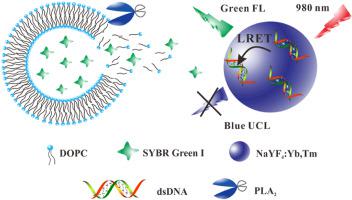当前位置:
X-MOL 学术
›
Anal. Chim. Acta
›
论文详情
Our official English website, www.x-mol.net, welcomes your
feedback! (Note: you will need to create a separate account there.)
Detection of phospholipase A2 in serum based on LRET mechanism between upconversion nanoparticles and SYBR Green I
Analytica Chimica Acta ( IF 5.7 ) Pub Date : 2021-01-01 , DOI: 10.1016/j.aca.2020.11.025 Dengwang Luo , Chaoyu Zhang , Yao Fang , Yiping Shen , Yuan Liang , Yaokun Xia , Fang Wu , Xiaosong Chen , Jingrong Liu , Jinghua Chen , Chunyan Li , Jianming Lan
Analytica Chimica Acta ( IF 5.7 ) Pub Date : 2021-01-01 , DOI: 10.1016/j.aca.2020.11.025 Dengwang Luo , Chaoyu Zhang , Yao Fang , Yiping Shen , Yuan Liang , Yaokun Xia , Fang Wu , Xiaosong Chen , Jingrong Liu , Jinghua Chen , Chunyan Li , Jianming Lan

|
Phospholipase A2 (PLA2) may be a vital biomarker for the prediction and diagnosis of some diseases. Consequently, it is of great significance to quantitatively detect PLA2 in biologic samples. Herein, on the basis of the principle of luminescence resonance energy transfer (LRET) between upconversion nanoparticles (UCNPs) and SYBR Green I (SG), we proposed a technology for the highly sensitive detection of PLA2 amount. Therein, as an energy receptor, SG will be quantitatively loaded into liposomes firstly. Then, due to the hydrolysis of liposomes under the catalysis of PLA2, SG will be released and inserted into the double-stranded DNA (dsDNA) on the surface of UCNPs, which triggers the LRET because of the shortening of effective spatial distance between UCNPs and SG. Under exciting of NIR light, UCNPs emit luminescence at 476 nm, which makes SG emit fluorescence at 522 nm through LRET. Under optimal conditions, the emission intensity ratio (I522 nm/I476 nm) increased linearly with the PLA2 amount in the range of 20 U/L to 400 U/L, and the limit of detection (LOD) reached 15 U/L. Here, after comparing with the clinical standard method, it is found that the biosensor is expected to provide a convenient and sensitive assay for the detection of PLA2 in actual serum samples. Furthermore, such biosensor can also be used to test the inhibitor of PLA2.
中文翻译:

基于上转换纳米粒子与SYBR Green I的LRET机制检测血清中磷脂酶A2
磷脂酶 A2 (PLA2) 可能是预测和诊断某些疾病的重要生物标志物。因此,定量检测生物样品中的PLA2具有重要意义。在此,基于上转换纳米粒子(UCNPs)和SYBR Green I(SG)之间的发光共振能量转移(LRET)原理,我们提出了一种高灵敏度检测PLA2含量的技术。其中,SG作为能量受体,首先被定量加载到脂质体中。然后,由于脂质体在 PLA2 的催化下水解,SG 将被释放并插入到 UCNPs 表面的双链 DNA(dsDNA)中,由于 UCNPs 和 UCNPs 之间的有效空间距离缩短,从而触发 LRET。 SG。在 NIR 光的激发下,UCNPs 发出 476 nm 的光,这使得 SG 通过 LRET 发出 522 nm 的荧光。在最佳条件下,发射强度比(I522 nm/I476 nm)在20 U/L~400 U/L范围内随PLA2用量线性增加,检测限(LOD)达到15 U/L。在此,与临床标准方法进行比较后,发现该生物传感器有望为实际血清样品中 PLA2 的检测提供一种方便且灵敏的检测方法。此外,这种生物传感器还可用于测试PLA2的抑制剂。结果表明,该生物传感器有望为实际血清样品中 PLA2 的检测提供方便且灵敏的检测方法。此外,这种生物传感器还可用于测试PLA2的抑制剂。结果表明,该生物传感器有望为实际血清样品中 PLA2 的检测提供方便且灵敏的检测方法。此外,这种生物传感器还可用于测试PLA2的抑制剂。
更新日期:2021-01-01
中文翻译:

基于上转换纳米粒子与SYBR Green I的LRET机制检测血清中磷脂酶A2
磷脂酶 A2 (PLA2) 可能是预测和诊断某些疾病的重要生物标志物。因此,定量检测生物样品中的PLA2具有重要意义。在此,基于上转换纳米粒子(UCNPs)和SYBR Green I(SG)之间的发光共振能量转移(LRET)原理,我们提出了一种高灵敏度检测PLA2含量的技术。其中,SG作为能量受体,首先被定量加载到脂质体中。然后,由于脂质体在 PLA2 的催化下水解,SG 将被释放并插入到 UCNPs 表面的双链 DNA(dsDNA)中,由于 UCNPs 和 UCNPs 之间的有效空间距离缩短,从而触发 LRET。 SG。在 NIR 光的激发下,UCNPs 发出 476 nm 的光,这使得 SG 通过 LRET 发出 522 nm 的荧光。在最佳条件下,发射强度比(I522 nm/I476 nm)在20 U/L~400 U/L范围内随PLA2用量线性增加,检测限(LOD)达到15 U/L。在此,与临床标准方法进行比较后,发现该生物传感器有望为实际血清样品中 PLA2 的检测提供一种方便且灵敏的检测方法。此外,这种生物传感器还可用于测试PLA2的抑制剂。结果表明,该生物传感器有望为实际血清样品中 PLA2 的检测提供方便且灵敏的检测方法。此外,这种生物传感器还可用于测试PLA2的抑制剂。结果表明,该生物传感器有望为实际血清样品中 PLA2 的检测提供方便且灵敏的检测方法。此外,这种生物传感器还可用于测试PLA2的抑制剂。











































 京公网安备 11010802027423号
京公网安备 11010802027423号